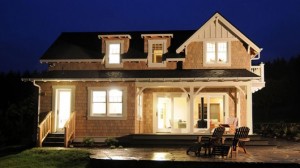Okay, this post might seem a bit off-topic, but it does suggest some things to think about vis-a-vis how we live.
Gizmag is a fun stop for people interested in new technology. I check it out every day while doing my rounds of the intertubes—hey, I’m a writer. It’s my job. Anyway, I highly recommend it. But some of the tech I read about is more useful than others. I saw something the other day that was very intriguing to me personally, and not just a way to turn your iPhone into a garden sprinkler or another solar-powered bottle opener.
I’m talking about prefab homes. Not just a re-purposed (oooh, I hate that word!) shipping container, but a real house with doors and windows and bedrooms and everything! Now this is nothing new, but it’s not something we see a lot of today.
When I went insane—the first time—after working in IT for many years, I got into the residential, new-construction industry for a change. I got there just in time to ride the construction wave as it crested and then crashed on the shoals of bad mortgages, over-supply of houses, and soaring fuel prices.
During the eight years we were in business, almost all the projects my company worked on were enormous monstrosities. The height of excess, these “homes” were rarely less than 10,000 square feet and included multiple kitchens and baths, wine cellars, game-rooms, bars, closets big enough for a family of four to live in, and garages big enough for a 747 with room for a Learjet and a boat besides. My company supplied custom cabinetry for these building projects. Needless to say, all this excess kept a roof over my head so I didn’t mind at the time.
It was very unsettling though as I watched first-hand how a builder-client of ours literally bought up an entire street of older homes so he could knock them down and build row upon row of McMansions to feed the ever-growing demand. This was going on all over the country and led to the demise of not just banks and builders, but many families as well.
Even more unsettling was the fact that, of the homes that weren’t built on spec, most were commissioned by childless couples, or very small families, 3< children. In only one case did we have a client who built a large home with the intention of living in it for a lifetime. In a rare display of frugality and foresight, they not only built the house with their own sweat-equity, but also a large family to live in it, complete with several dogs. They live there today with extended family living nearby. Sadly, most of the rest of our clients no longer live in the homes they built.
Now, don’t get me wrong, I have no problem with people spending their hard-earned money on anything they want as long as it’s legal, but I could never understand the need for a gigantic house just so you can impress people. I live in a house that’s “only” 2,400 sq feet (Ha! The fact is, I live in only about 500 square feet of it). I despair of ever keeping it clean. The maintenance alone is always weighing on me, especially when I have to paint, or swap out water heaters. I would do well with much less.
The problem as I see it, is that as a society, we’re really into consumption, often for consumption’s sake. Look at the housing boom and resulting mortgage crisis: many otherwise rational people, misled by greedy mortgage brokers, and seduced by the consumption bug, bought way more house than they could really afford, just because they could. When the rates adjusted, they were out of money, then out of a home. Fast. Or the house they bought at a ridiculously inflated price was suddenly worth less than half, leaving them hopelessly underwater. Unable to sell, and unable to pay, many families were faced with foreclosure. All because of over consumption and unsustainable growth.
And just building those houses took gobs of money and years to complete. Each project sucked up resources in ways you can’t imagine: fuel, people, lumber, metals, materials of every kind. But now, having hopefully learned our lesson, at least on the housing front, we are beginning to see more enlightened architects and builders popping up. They are offering their clientele smaller, more energy efficient, and sustainably built houses, with no loss of customization options. Method Homes, is an example of this new way of thinking about home-building.
However, building this way requires a little mental re-wiring. When we realize that we really don’t need the extra car, TV, or 2,000 square feet, it can be liberating. We begin to be aware of all the other accretions to our life that add zero value, and may in fact reduce our overall quality of life.
Applying the principle of sustainability to all areas—food, clothing, possessions, even habits and behaviors—can result in vast improvements in our usual debt-burdened, overfed, over-anxious existence. Smaller doesn’t always mean better, but thinking smaller can often lead to just right.

